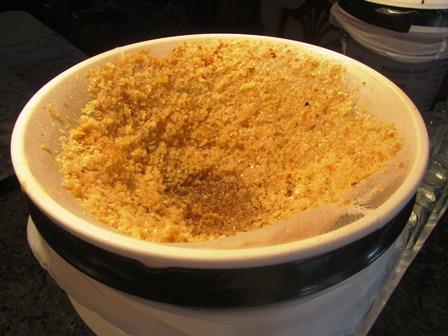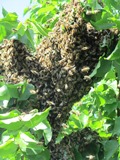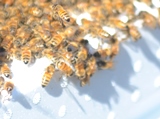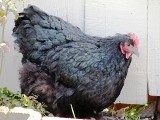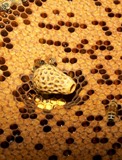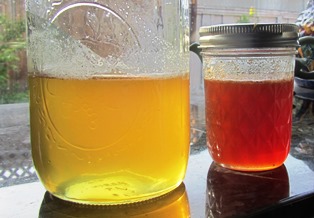First the Harvest, then the Floor
My kitchen floor was littered with bits of wax and bee glue yesterday. It took me over an hour on my knees to scrub and clean it after I had uncapped thirty frames of honey I’d taken from my hives.
In the process of scraping each frame and then unsealing all the capped cells on the front and back of each frame, drops of wax and propolis, or bee glue (created by the bees from bee saliva, wax, and exudate from botanical sources) fell to the floor. I tracked it from the counter, sink, and extractor on the soles of my shoes.
Even before I put my honey buckets under the extractor spigot, I tape fine mesh strainers over the buckets to catch wax and other debris.
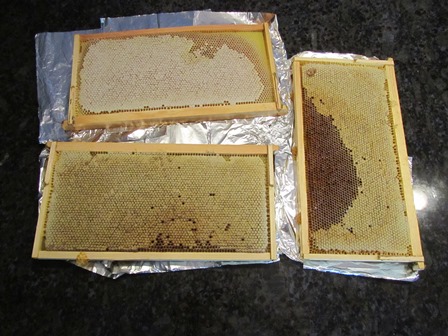
Three frames containing honey, but the sweet stuff is locked inside a honeycomb of cells sealed with wax by the bees
Once all the frames are processed and the buckets are sealed, I put the wax I’ve removed from the frames into a mesh bag to drain the honey (usually a much smaller quantity of honey is recovered from this process).
When the honey has been removed from the mesh bag, I place that wax on a cookie sheet and set it in the garden for the bees to clean. After the bees have cleaned all the wax (by eating any drops of honey left), I save the wax to melt into bars for candles or soap-making.
Back in in the kitchen, the extractor, it must be washed inside and out. Once cleaned and moved to the patio, I must start removing the wax and propolis from the floor. For that, I use an old thin, metal spatula to scrape the tile free of wax.
A soap and water scrub follows. Then I rinse and dry the floor with rags before moving the honey extractor back into the kitchen.
I won’t take honey again until next year. But now the honey must be bottled–that means I must sterilize bottles and prepare labels. Keeping honeybees is really only this labor intensive during and after the honey harvest. But the harvest is well worth all the work.
If you enjoy reading about farmette topics (including gardening, beekeeping, and delicious recipes), check out my cozy mysteries A BEELINE TO MURDER and also THE MURDER OF A QUEEN BEE in the Henny Penny Farmette series (from Kensington Publishing).
* * *
Enjoy reading about farming topics? Check out my cozy mysteries–A BEELINE TO MURDER and also THE MURDER OF A QUEEN BEE (both in the Henny Penny Farmette series from Kensington Publishing).
These novels are chocked full of recipes, farming tips, chicken and beekeeping tips, sayings and, of course, a charming cozy mystery. For more info, click on the links under the pictures.
The books are available through online retailers such as Amazon, Barnes & Noble, Kobo Books, and Walmart as well as from traditional bookstores everywhere.
See, http://tinyurl.com/hxy3s8q
This debut novel launched the Henny Penny Farmette series of mysteries and sold out its first press run. It’s now available in mass market paperback and other formats.
See, http://tinyurl.com/h4kou4g
NEWLY RELEASED! This, the second cozy mystery in the Henny Penny Farmette series, is garnering great reviews from readers and industry publications.
Henny Penny Farmer’s Almanac–Sayings
Humans could learn a thing or two from the world of honeybees where all endeavor benefits the entire colony, not an individual bee.
A tea made of meadowsweet, chamomile, or peppermint herbs can calm an upset stomach.
To get stronger egg shells, feed your chickens extra calcium.
Producing manure is easy; it’s the moving of it that takes patience and the right shovel.
Sow above-ground plants during a waxing moon and below-ground plants during a waning moon.
The simplest treatment for a bee sting is to get the stinger out.
Move chickens and bees at night; when they awake in the morning, the move is a fait accompli.
If you enjoy listening to songbirds, it might interest you to know the male is generally the singer since he uses song to attract a mate and defend his territory.
Birds don’t just sing; they call, and their calls are how they communicate
with a partner or sound the alarm that a predator is near.
Box and jug wines are fine as long as you never drink or cook with a flawed wine.
Use a dab of raw honey or bee propolis to treat a peck wound on a chicken as honey and propolis have antiseptic, antibacterial properties.
Each nostril of a dog’s highly sensitive nose can separately track scents—a skill proving useful to humans in finding illegal drugs, locating dead bodies, and even detecting cancer.
Red wine remains drinkable for decades because the tannins act as a natural preservative; however, the wine must be properly bottled and stored.
If you want to lower your cholesterol, decrease your stress level
and improve your blood pressure, adopt a dog.
Pacific oysters can engage in annual sex reversals; male one year, female the next—one of nature’s many surprises.
Help your chickens go through the molting process (when they lose feathers and stop egg production) by feeding them 20 percent more protein and limiting their stressors.
Time spent in a garden is a lot like yoga; it slows the breath, quiets the mind, and lets you get to the truth.
To break your dog’s habit of licking you, get up and go into another room
immediately when the licking starts so the animal will associate its licking with your leaving.
If you don’t want to be devoured by insects, wear light colors when gardening.
If you want to strengthen your immune system, consume a teaspoonful of raw buckwheat honey every day.
A honeybee queens live 10 times longer than her worker bee sisters and while they are sterile, the queen remains reproductive throughout her life.
To keep your bee colony strong and robust, feed your honeybees when their food sources become scarce.
To make a fat-free broth, pour the juices of a roasted chicken or turkey into a wide-mouth jar and refrigerate until solidified; then, skim away the fat that has risen to the top.
You can’t shift the status quo if you don’t take action.
When relationships sour like beans and bitter herbs, an hour in a garden
can generate the sweetness of new dreams.
©November 2013 by Meera Lester
Permission is granted for use of individual quotes, provided the quoted material contains the following credit: “Used with permission from Henny Penny Farmers’ Almanac.”
Seasonal Flowers Change the Taste and Color of Honey
If you’ve ever wondered where honey gets its color and taste, think flowers. Or, more correctly, pollen from the flower and herb blooms and tree blossoms.
In the environs that encompasses roughly five to ten miles around the Henny Penny Farmette, honeybees gather pollen from blossoms on lavender, citrus, sunflowers, cosmos, fruit trees, and other flowering trees. Bees collect pollen from cultivated gardens but also from plants growing wild on hillsides and in the meadows and fields.
The first woodland flowers and wildflowers of spring yield honey that is a pale lemon color and tastes sweet and light. Later in the season, the pollen bees collect from citrus tree blooms such as orange blossoms becomes honey with citrus notes and aroma. When certain types of eucalyptus trees bloom in September, the honey takes on a warm amber color and a strong and earthy taste.
Dark honey is also found in a spring hive. It can be traced to the pollen that the bees have discovered and gathered from blossoms and blooms of flowers, trees, or herbs with a strong flavor and dark color.
If you want the health benefits from honey, purchase the raw honey. Raw honey is high in antioxidants and also has immune-boosting properties, according to Dr. Tasneem Bhatia, from the Atlanta Center for Holistic and Integrative medicine.
In a December 2012 appearance on the Dr. Oz show, Dr. Bhatia recommended people take 1 to 2 teaspoonfuls of buckwheat honey every day as a natural remedy for cold, sore throat, and flu symptoms. See, http://www.prweb.com/releases/honey/buckwheat-honey-raw/prweb10242276.htm
Raw honey means it has not been heated or otherwise adulterated by processes that reduce or compromise the healthy benefits. Beneficial enzymes, propolis, pollen, minerals, vitamins, amino acids, and antioxidants are destroyed when the honey is heated.
Drink your hot tea or warm milk with honey, but don’t put the honey in the cup of liquid and stick it into the microwave. Warm the liquid first, then add the honey.
It matters not whether your taste leans toward the light honey or the dark, the liquid honey or the honeycomb, have some honey every day. It’s good for you.
 Facebook
Facebook Goodreads
Goodreads LinkedIn
LinkedIn Meera Lester
Meera Lester Twitter
Twitter





